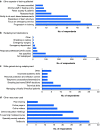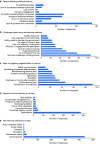Impact of the SARS-CoV-2 (COVID-19) crisis on surgical training: global survey and a proposed framework for recovery
- PMID: 33855364
- PMCID: PMC8047098
- DOI: 10.1093/bjsopen/zraa051
Impact of the SARS-CoV-2 (COVID-19) crisis on surgical training: global survey and a proposed framework for recovery
Erratum in
-
Corrigendum to: Impact of the SARS-CoV-2 (COVID-19) crisis on surgical training: global survey and a proposed framework for recovery.BJS Open. 2021 Jul 6;5(4):zrab055. doi: 10.1093/bjsopen/zrab055. BJS Open. 2021. PMID: 34401901 Free PMC article. No abstract available.
Abstract
Background: The SARS-CoV-2 pandemic had a profound impact on surgical services, potentially having a detrimental impact on training opportunities. The aim of this global survey was to assess the impact of the COVID-19 crisis on surgical training and to develop a framework for recovery.
Methods: A cross-sectional, web-based survey was conducted. This was designed by a steering committee of medical educationalists and validated by a group of trainees before dissemination.
Results: A total of 608 responses were obtained from 34 countries and 15 specialties. The results demonstrated major disruption in all aspects of training. The impact was greatest for conferences (525 of 608) and hands-on courses (517 of 608), but less for inpatient care-related training (268 of 608). European trainees were significantly more likely to experience direct training disruption than trainees in Asia (odds ratio 0.15) or Australia (OR 0.10) (χ2 = 87.162, P < 0.001). Alternative training resources (webinars, 359 of 608; educational videos, 234 of 608) have emerged, although trainees expressed some dissatisfaction with them. The collective responses generated a four-pillar framework for training recovery that involved: guidance from training stakeholders with the involvement of trainees; prioritization of training, especially the roles of senior surgeons/trainers; provision of access to alternative/new teaching methods; and measures to address trainee anxiety.
Conclusion: Training has been greatly affected by the COVID-19 pandemic. The introduction of new teaching methods and a focus on training after the pandemic are imperative.
Antecedentes: La pandemia por SARS-Cov-2 tuvo un impacto profundo en los servicios de cirugía, lo que podría causar un efecto perjudicial en las oportunidades de formación. El objetivo de esta encuesta global fue evaluar el impacto de la crisis de la COVID-19 en el entrenamiento quirúrgico y desarrollar un marco para la recuperación.
Métodos: Se realizó una encuesta transversal por Internet, la cual fue diseñada por un comité directivo de educadores médicos y validada por un grupo de profesionales en periodo de formación antes de su difusión.
Resultados: Se obtuvieron 608 respuestas de 34 países y 15 especialidades. Los resultados demostraron importantes interrupciones en todos los aspectos del entrenamiento. El impacto fue mayor para las conferencias (525/608) y los cursos prácticos (517/608), pero menor para la formación relacionada con la atención hospitalaria (268/608). Los profesionales en periodo de formación europeos fueron significativamente más propensos a experimentar interrupciones directas en el entrenamiento que los de Asia (odds ratio 0.15) o Australia (OR 0.10) (χ2 = 87.162, P < 0.001). Han surgido recursos de formación alternativos (seminarios web: 359/608, videos educativos: 234/608), aunque los alumnos expresaron cierta insatisfacción con ellos. Las respuestas colectivas generaron un marco de cinco pilares para la recuperación de la formación que implicaron: priorización del alumno y seguridad pública; orientación de las partes interesadas en la formación con la participación de los alumnos; priorización de la formación, especialmente de las funciones de los cirujanos senior/ profesores; facilitación de acceso a métodos y medidas de enseñanza nuevos o alternativos para abordar la ansiedad de los alumnos.
Conclusión: La formación se ha visto muy afectada. Es imperativo introducir nuevos métodos de enseñanza y poner énfasis en la formación después de la pandemia.
© The Author(s) 2021. Published by Oxford University Press on behalf of BJS Society Ltd.
Figures






References
-
- WHO. Coronavirus Disease (COVID-19) Outbreak. https://www.who.int/westernpacific/emergencies/covid-19 (accessed 22 March 2020)
MeSH terms
LinkOut - more resources
Full Text Sources
Other Literature Sources
Medical
Miscellaneous

